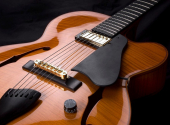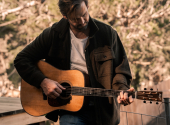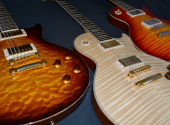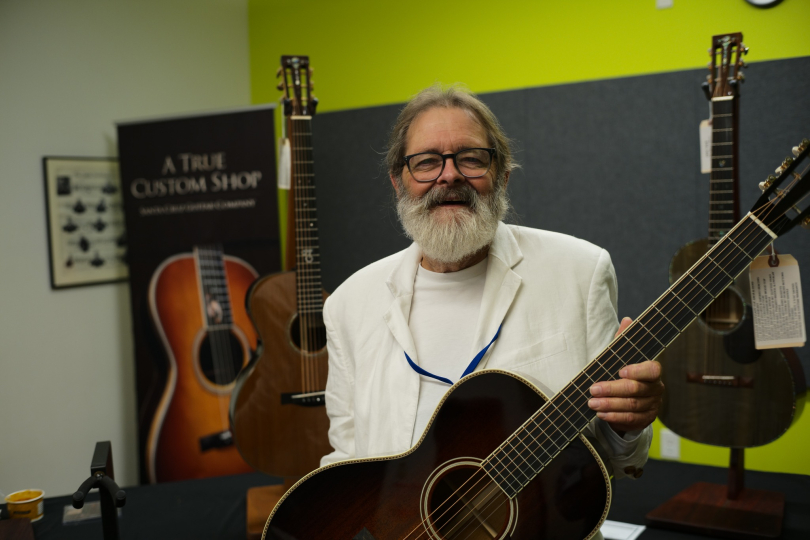
Legendary and Mythical Guitars #1: Santa Cruz Guitar Company
As the name suggests, this series will explore guitars that few people own, but many people dream about. We are going to look at brands that are rather rare or whose price falls into the "Unavailable" category. In many cases, it will be a combination of both. You may have heard the names, seen some top musicians playing them, but never researched their makers or history. Our series will primarily aim to explain the core philosophies of each manufacturer and help you get a better sense of what's going on at the top end of the guitar industry. We'll alternate between acoustic brands and electric brands, but of course, sometimes we'll feature both types of guitars from the same manufacturer. We're opening with SCGC.
First meeting
It was at the NAMM Show in Anaheim, California. I was walking down an aisle in the acoustic guitar section, polished instrument tops reflected on my face and logos of famous brands were glowing on each side, overshadowing the illuminated posters of admired endorsees and chrome bar stools with company labels. Then I caught a glimpse of a large, dark stand, with a couple of guitars on the wall and a table and chair in front of it. I turned around to see if I wasn't imagining things and went to check out what kind of character was sitting there.
The writing on the wall read Santa Cruz Guitar Company in plain, unlit letters. Behind a shabby desk, I saw a petite white-haired gentleman of experienced age with a keen and friendly eye. It wasn't until later that the context dawned on me. Sure enough, the gentleman would be Richard Hoover, the legendary owner and mastermind behind a small, but much admired, guitar company. We started chatting. Richard was alone at the trade show booth most of the time and told anyone who cared to listen, passionately but not insistently, about the guitars hanging on the wall. It was obvious that he knew more about guitar-making than most people in the world.
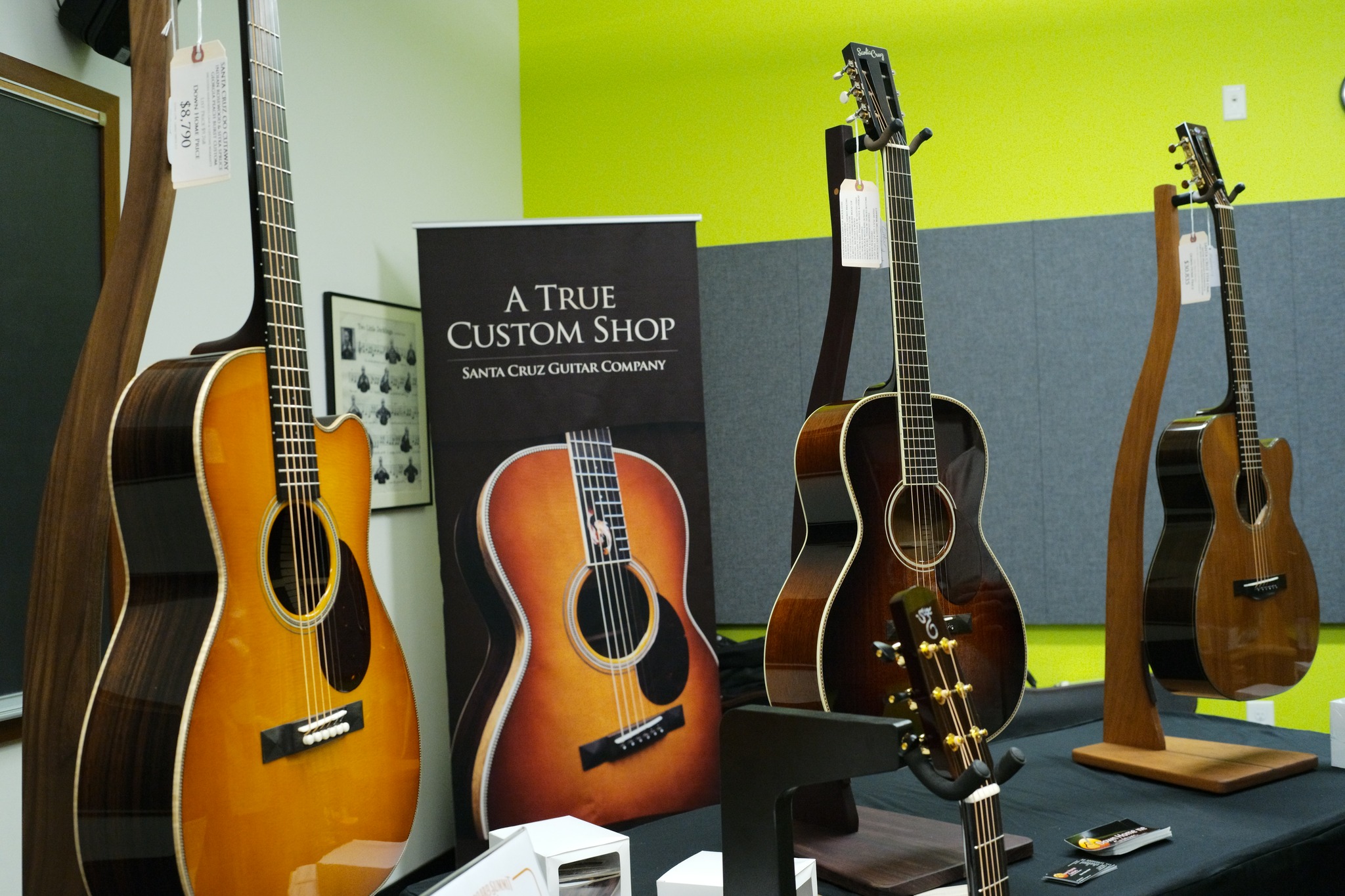
A skilled repairman imitating violin makers
Test for smart kids, question one: in which city are Santa Cruz guitars made? Well done! You guessed it, it's Santa Cruz! Question two: Where is Santa Cruz located? That's a tougher one, isn't it? It's on the California coast south of San Francisco. The city's population today is about 60,000.
In the '60s, a guy named Richard Hoover opened a guitar repair shop there and tried to build some guitars himself. He was inspired by books on violin making that his mother, a librarian, got him. Eventually, he became well known in the town's guitar community and got approached by two investors who were thinking of starting a guitar manufacturing business.
The official foundation of the company dates back to 1976. The first model was marked "D" representing the dreadnought. The next model was named FTC and stood out with its arched back (later a flat version called F was also made). Eric Clapton bought one of these. But the real breakthrough into the world of exclusive guitars was the collaboration with Tony Rico. One of the most famous bluegrass guitarists of all time had a twenty-eight Martin at the time, but it had undergone many modifications by various guitar makers – and Richard integrated these into a special model, which Rice then took all over America and gave the company a good publicity push.
By the end of the 1980s, Richard had bought out both partners and became the sole owner of the company. He gradually expanded the range of models and their variants. He added small-bodied guitars, and gradually expanded the list of modifications to each model – to the point where the company now operates as a custom shop where anyone can configure a guitar pretty much to their own specifications.
Lots of luthiery, no polishes
SCGC is known for the sound quality of its guitars. Richard uses voicing and tap tuning on both the top and back plates. He adjusts the bracing individually and connects the neck to the body with a dovetail joint. All of these procedures are borrowed from violin makers.
When it comes to lacquers, he uses nitrocellulose exclusively. He says that cellulose is essentially wood, so he puts 'wood on wood'. The more SCGC guitars dazzle with their sound, the less they shine with hi-gloss lacquers. On the contrary, everything is in a natural or satin finish – a relatively thin layer of lacquer that is not polished to a gloss. If the customer wants the top slightly tinted or in a sunburst finish, both can be ordered. However, you can't get coloured lacquers (like black) here. I'm not surprised. Only a barbarian could paint such beautiful tops.
Of course, the goal is to achieve what all guitarists want to hear – long sustain, a sound rich in higher harmonics, elimination of unwanted frequencies, and balanced sound across the frequency spectrum. With about 500 guitars produced per year (which is equivalent to about two days of production in big guitar companies), the factory can spend a great deal of time on every guitar. Naturally, this will show in the price, but that's how SCGC has built its business model. If you want to save money, you just have to go elsewhere.
It is also worth mentioning that Richard went to such lengths in his attention to detail that he developed his own strings. His motto is: "The gauge of the string is not important, it's the tension that counts." The SCGC strings are distinguished from others by a very precise ratio between core diameter and winding and boast perfectly balanced volume and frequency characteristics of the individual strings. They are coated with a protective layer and come in low-tension and mid-tension versions to fit the different guitar models.

Eight basic models in many variants
SCGC currently offers the following basic models:
- Baritone
- Dreadnought
- Slope Shouldered Dreadnought
- F (Fingerstyle, like a small jumbo)
- H (something between OM and grand auditorium)
- OM/OOM
- Small-Bodied
- Bass
Number of top material variants: 12 (in addition to all possible spruce species, there are also cedar, mahogany, koa and redwood).
Number of back and side material variants: 14 (in addition to rosewood and mahogany, there are also cocobolo, koa, walnut, blackwood and plane).
Necks: mahogany or maple
Fingerboards: rosewood or ebony.
Other options: 20 types of rosettes, 9 types of bindings, 17 types of purflings, headstock, fingerboard and heel inlays, cutaway, 12 strings, left-handed version.
11 finish options (natural finish, tinted, sunburst).
50 dealers per universe is enough
SCGC sends its instruments worldwide exclusively through dealers. Therefore (except in China) it does not work with national or multinational distribution companies but supplies directly to retailers. You could almost say retail stores, although some of them have an online section. In any case, the manufacturer avoids working with online giants and chooses retailers focused on more expensive goods. Given its positioning, this is quite logical. Santa Cruz customers are willing to pay well above average for a guitar. Therefore, they also expect proper service, the expertise of the sellers, their time and attention.
The focus on the domestic market is evident. Out of about 50 dealers, 30 are American. The rest are spread all over the world. In Europe, you can buy their guitars in Germany, Switzerland and The Netherlands. What do they have in stock at the moment? Five new pieces, dreadnoughts and OM Custom. For example: the standard dreadnought, a combination of spruce top and rosewood back & sides is priced at 7,190 Euro.
Well, here we are talking about money again. If you want a Santa Cruz guitar, you need a really big piggy bank at home. The cheapest "basic" models are around 5,000 Euro and the standard is around 8,000, but if you splurge a little, you can get up to 22,000. However, it is important to mention that SCGC takes exemplary care of its buyers and is scrupulous about its reputation as a company that will never let a customer down if they have any problems with an instrument. So you are buying a form of warranty with the instrument (in addition to the legal one) that you can always use to reach for assistance in a technical emergency.
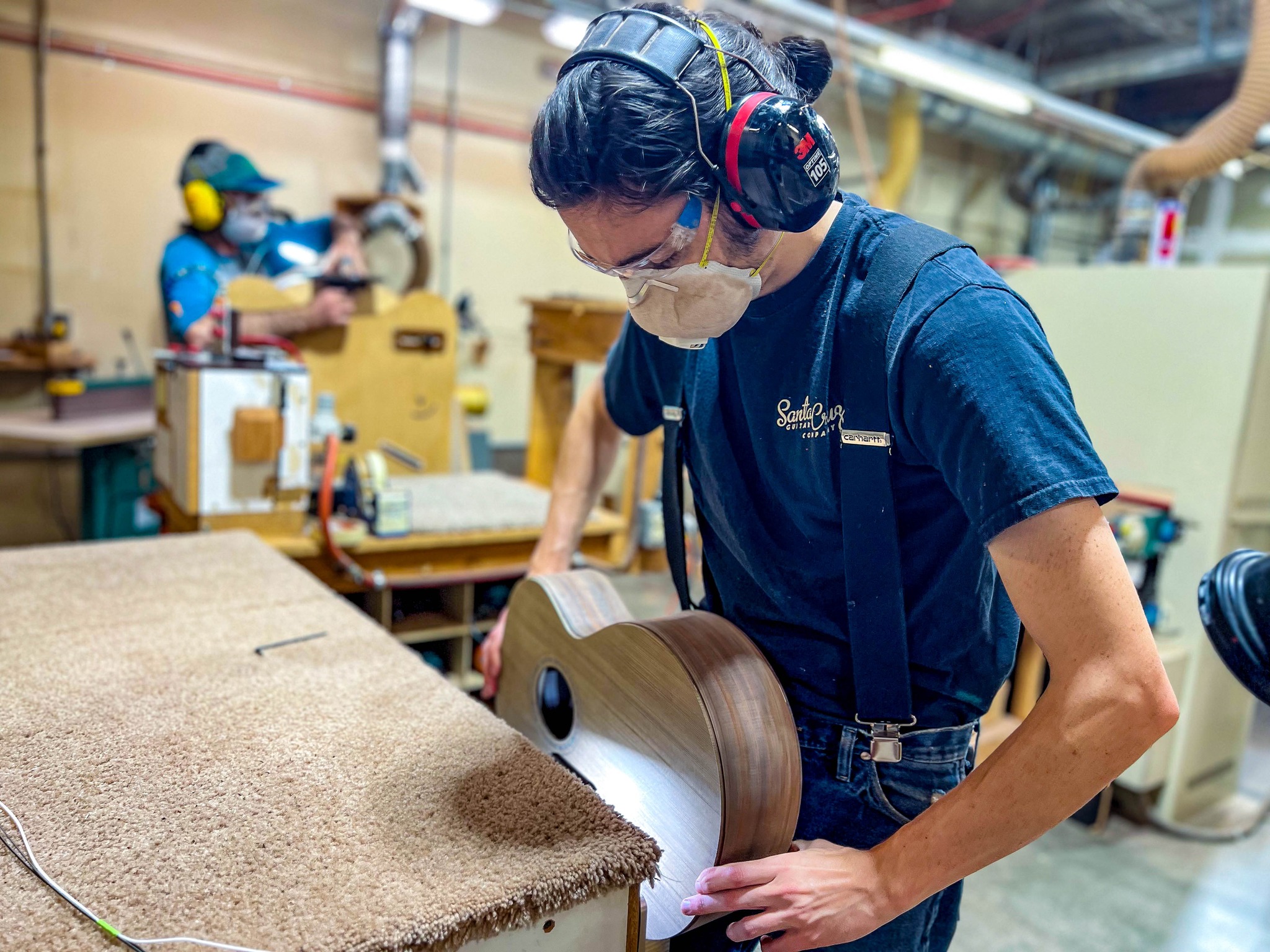
Who's buying it? Americans sure do
Almost every successful guitar company has had a musician in its history who made a significant impact on the guitar public. Taylor had Neil Young, Takamine had Garth Brooks, and so on. Richard and his crew were brought to prominence by Tony Rice, as we've already said. But Brad Paisley, Otis Taylor and Jack Black – the star of many films and videos, like the ones with the Foo Fighters – also own their instrument. And even Robert Plant has one piece.
It's safe to say that Santa Cruz players come from many genres and playing styles. They include flat pickers from bluegrass bands, songwriters and die-hard fingerstylists. Given the geographic division of the dealer network, it's understandable that the vast majority of SCGC guitar owners reside in the US.
Conclusion: a heartfelt business
If you get a chance to talk to kind and charismatic Richard for a while, you will quickly develop a positive relationship with his instruments. You almost feel that this nice guy can never make or sell any junk. That's just not possible! And the company's business philosophy is largely based on friendly relations with customers.
But of course, in a market as competitive as the US, friendship alone wouldn't be enough to make a customer shell out $10k for a single guitar. So the essential selling points are perfect materials, meticulous craftsmanship, and a high degree of customisation. SCGC guitars play great and Richard Hoover will forever be a legend.

If you have found an error or typo in the article, please let us know by e-mail info@insounder.org.


